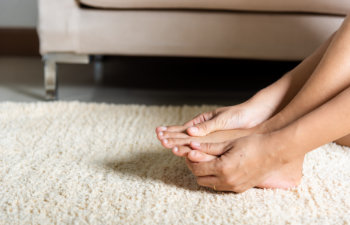Tailor’s Bunions: Causes, Symptoms and Treatments

Tailor’s bunions, also known as bunionettes, are a common foot condition characterized by a bony prominence on the outside of the foot near the base of the little toe. Similar to traditional bunions that develop on the inside of the foot, tailor’s bunions can cause discomfort and affect mobility if left untreated. Understanding the causes, symptoms and treatments of tailor’s bunions is essential for effective management and relief. Here is what you need to know.
Causes
Tailor’s bunions typically develop due to a combination of genetic predisposition and external factors. Some common causes include:
- Foot Structure: Individuals with certain foot structures, such as a high arch or a wide forefoot, may be more prone to developing tailor’s bunions.
- Footwear: Tight, narrow, or ill-fitting shoes can exert pressure on the outside of the foot, leading to the development of tailor’s bunions over time.
- Biomechanical Issues: Abnormal foot mechanics, such as overpronation or supination, can contribute to the formation of tailor’s bunions by altering the distribution of weight and pressure on the foot.
- Injury or Trauma: Previous injury or trauma to the foot, such as a fracture or sprain, can predispose individuals to develop tailor’s bunions later in life.
Tailor’s Bunion Symptoms
Tailor’s bunions can cause a variety of symptoms, ranging from mild discomfort to significant pain and mobility issues. Common symptoms include:
- Bony Prominence: A noticeable bump or protrusion on the outside of the foot, near the base of the little toe.
- Pain: Pain and tenderness at the site of the bunion, particularly when walking, standing, or wearing tight shoes.
- Swelling: Inflammation and swelling around the bony prominence, which may worsen with prolonged activity or pressure on the foot.
- Redness and Irritation: The skin overlying the bunion may become red, irritated, or calloused due to friction and pressure from footwear.
- Limited Mobility: Severe tailor’s bunions can cause limited mobility and difficulty wearing shoes comfortably, leading to changes in gait and posture.
Treatments
The treatment of tailor’s bunions aims to alleviate symptoms, slow the progression of the condition and improve overall foot function. Common treatment options include:
- Footwear Modification: Wearing shoes with a wide toe box and soft, supportive materials can help reduce pressure on the bunion and alleviate discomfort.
- Orthotic Devices: Custom orthotic inserts or pads can help redistribute weight and pressure on the foot, providing relief from pain and improving foot mechanics.
- Padding and Taping: Padding the bunion with moleskin or gel pads can cushion the area and reduce friction, while taping techniques may help realign the toe and alleviate pressure.
- Medications: Over-the-counter pain relievers, such as ibuprofen or acetaminophen, can help manage pain and inflammation associated with tailor’s bunions.
- Physical Therapy: Stretching exercises, strengthening exercises and manual therapy techniques can help improve foot mechanics, flexibility and strength, reducing the risk of further complications.
- Injection Therapy: Corticosteroid injections or ultrasound-guided injections of platelet-rich plasma (PRP) may be recommended to reduce inflammation and alleviate pain in severe cases.
- Surgery: In cases where conservative treatments fail to provide relief, surgical intervention may be necessary to correct the deformity and realign the bones of the foot. Surgical procedures for tailor’s bunions typically involve removing the bony prominence, realigning the toe joint and stabilizing the foot with screws or pins, which can be completed by Stuart J. Mogul, DPM, FACFAS, NYC’s renowned foot specialist.
Tailor’s bunions can cause discomfort and affect mobility, but with proper diagnosis and treatment, individuals can find relief and improve their quality of life. By understanding the causes, symptoms and treatment options for tailor’s bunions, individuals can work with Stuart J. Mogul, DPM, FACFAS, to develop a comprehensive management plan tailored to their specific needs and preferences. Early intervention and proactive management are key to preventing the progression of tailor’s bunions and minimizing their impact on daily activities and overall foot health. To schedule a bunion exam and consultation with Dr. Mogul, contact our office in New York City.
Posted on behalf of
1111 Park Avenue Suite 1B
New York, NY 10128
Phone: (212) 769-0066
Email: contact@footsurgerycenternyc.com
Monday - Friday 8:30 AM – 6:00 PM
